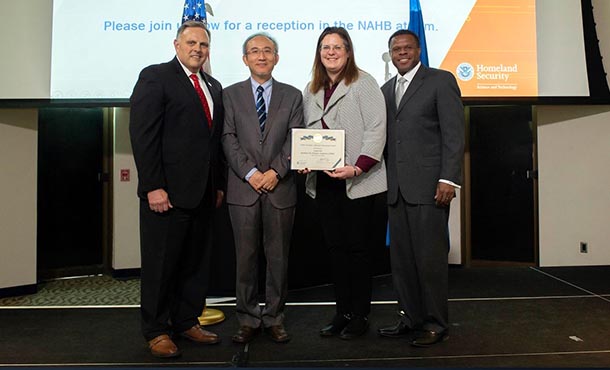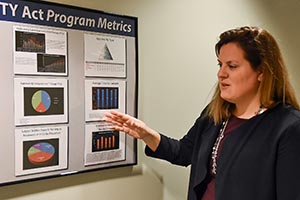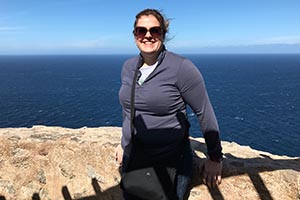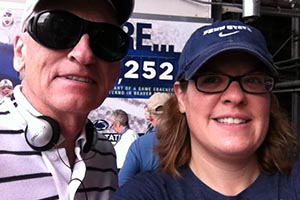
Itle received the 2019 Department of Homeland Security Under Secretary of Science and Technology special achievement award. Left to right: William Bryan, senior official performing the duties of the undersecretary for science and technology; Dennis Kimko of the Institute for Defense Analyses; Laura Itle; André Hentz, acting deputy undersecretary, science and technology of the Department of Homeland Security. IMAGE: DHS SCIENCE & TECHNOLOGY DIRECTORATE
Alumni Spotlight: Laura Itle
3/30/2020
Laura Itle is an Institute for Defense Analyses (IDA) research staff member and the project leader for IDA’s support of the Department of Homeland Security’s (DHS’s) Office of SAFETY (Support Anti-Terrorism by Fostering Effective Technologies) Act Implementation. Itle is also a Penn State chemical engineering alumna, earning her doctoral degree in chemical engineering in 2005. Her focus was originally pharmaceuticals, but the tragic events of Sept. 11, 2001, and concern about a relative serving in the military changed her career goals to anti-terrorism and military equipment testing. She recently talked about what she does to protect America from terrorism, a recent prestigious award her team received for their work and some fond memories of her days as a Penn State graduate student.
What does your work at IDA entail?
I work at what is known as a Federally Funded Research and Development Center. We are tasked to do independent, objective and rigorous analyses to address national security challenges. My current job at IDA, which I’ve had since 2007, is to lead a team of about 15 full-time researchers and 80 to 90 subject matter experts who look at the technical effectiveness of anti-terrorism technologies for a DHS program called the SAFETY Act. We do a stem-to-stern business assessment and technical assessment to see if products and services that could have anti-terrorism benefits to the United States work as described and have been rigorously tested to see if they have potential to perform when fielded. If what we are dealing with is more security related, then we make sure that the security people are trained to help spot potential terrorist activities or threat objects.
We assess anything from X-ray machines to security programs at professional sports stadiums and airports, and then we help in the background doing assessments of the technologies and developing methods for those assessments.
What got you interested in the anti-terrorism field?
I think that my career was a bit accidental. When I started at Penn State in August 2001, I came in thinking I was going to get my doctorate in chemical engineering and then go work in pharmaceutical development at Merck or something similar and work on process design and new product development.
I was sitting in my office the morning of Sept. 11, 2001, in the basement of Fenske Lab, and somebody knocked on my door to tell me a plane had hit the World Trade Center. If you were on campus on that day, everyone kind of rushed to the HUB and we were watching the basically non-stop news. I think the world changed so much that day, and my research interest and focus ended up changing with it.
Instead of looking at rapid methods to screen potential drug candidates, we started looking at rapid methods for detecting biowarfare agents and potential biological threats both to our warfighters and domestically. About a year or two later, one of my cousins was deployed to Iraq with the Army. So when I finished my dissertation, I thought of the experiences my cousin was having and IDA was a place where I could combine my research interests with my desire to try to help our servicemen and women. Then, I just sort of fell into the task I’m doing now, combining methodologies and doing technology assessments for DHS. It is work that can have value in keeping Americans safe in general and also to try to directly help the warfighter.
Your team recently received a 2019 DHS Undersecretary of Science and Technology Special Achievement Award. Talk a little bit about what that award is, and why your team received it.
The award recognized the fact that we were tackling, even with adverse conditions, some very big projects.
A couple that come to mind were assessments of the Port Authority Trans-Hudson Railway System’s breach mitigation system, the new Little Caesars Arena in Detroit and their operational security programs, a number of NFL and MLB stadiums and a bunch of other security technologies. It was really a recognition of the magnitude of the work we’re doing to help the DHS mission overall but also the ability to perform under less-than-ideal circumstances.
How do you apply what you learned at Penn State to what you do at IDA?
By way of background, I actually came through the Huck Institutes of the Life Sciences’ Molecular, Cellular, and Integrative Biosciences program, which was then called the Huck Institutes’ Integrated Biosciences program. At the time, 20 years ago, the idea was to mix up engineers, chemists and biologists so you could form a team to tackle interdisciplinary problems. In my time at Penn State, one of the critical parts of what I was doing was working in an interdisciplinary environment and building teams to solve research problems. That’s essentially what I do on a day-to-day basis at IDA.
What I learned to do at Penn State is to pull in people who know far more than I do about certain subjects and organize them in a way that we can solve the problem together. I think all engineers and anyone in a science program at Penn State really learn to be methodical about problem solving. There is a logical and methodical way to approach a research question, no matter what field you’re in. I could be doing that in traditional chemical engineering for a career, but in my job I’m doing things like analyzing a stadium for risks. However, I’m still following that logical thinking, problem-solving approach; digging through research papers, looking at standards and pulling together all sorts of information. The stuff I do daily is exactly what I learned to do in graduate school at Penn State.
What are a few of your favorite Penn State memories?
I am from a Penn State family. I grew up wearing Penn State sweatshirts in Wisconsin Badger territory. I remember my first fall on campus and going to my first Penn State football game at Beaver Stadium with my dad, Mark Itle, who graduated from Penn State in 1967. Finally going to a football game in person after watching all those games on TV with my dad was fantastic.
I think like every student at Penn State I ate far too much ice cream at the Creamery. My first office in Fenske Laboratory was right across from the old Creamery when it was kind of in the middle of campus. We would go every single day to have a bagel and lemonade in the morning and ice cream in the afternoon. I just remember sitting in the parking lot and eating all of our ice cream.
Other memories come from graduate students being such exceptional community builders. I just remember the group of people made up of labmates, people from chemical engineering and other graduate students I knew. Just memories of seminars, happy hours, weddings, wedding receptions and even going out with a group of grad students to see Star Wars movies. I think being part of the community at Penn State was just fantastic.
Name a few individuals who have inspired you in your life and why.
I draw most of my lessons from the remarkable women in my family. The first one that comes to mind is one of my late great aunts, Sister Mary Regina Sutton. She was part of the Catholic Religious Sisters of Mercy in California. Along with being a religious sister, she had a maste’s of mathematics from Notre Dame, was a certified locksmith, had certificates in electronics and radio and even had a hobby making various jams. She spent a lot of time teaching her great nieces and great nephews to love to learn, take on challenges and never be afraid to extend yourself and take up a new field. I think the hallmark of my career has been trying something new and working to excel at whatever it is.
The other person who really has been my inspiration, and still is, is another family member, my cousin Meg Scott, another Penn State graduate (1992, agricultural sciences). Unfortunately, she passed away a year ago after a lengthy illness. She was a source of optimism. I think I work in a space where you can be very cynical, because as researchers we question everything. She was my inspiration to be optimistic, to be hopeful, to embrace every day and to aspire to do good every day. Just to remember that if you do good every day, that’s enough.
What is the most interesting thing about you that we would not learn from your résumé?
About 10 years ago I got really interested in how whiskey and bourbon are produced. I have a great group of friends and we actually travel about every year to various distilleries and whiskey-making places. We’ve gone all over Scotland, we went to Ireland last year, we did a trip through Kentucky to all the bourbon places and we’re planning for a Japan trip. So, at any given day or time you can find a decent selection of scotch, bourbon and other whiskeys at my house.
In terms of other things, I kickbox which means everyone needs to be a little cautious around me. Just in case I decide to do a roundhouse to the head [laughs]. And, I do a lot of running when I can.






